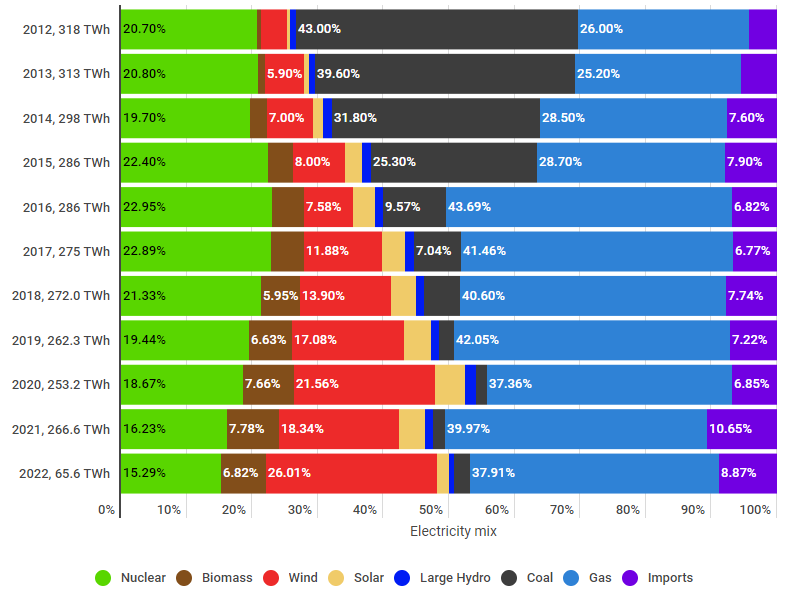GUEST BLOG BY LOGAN BLACK https://www.linkedin.com/in/logangblack/
Number 10 and BEIS are making rumbling noises about launching a new UK energy strategy. This energy strategy is likely to focus on the ‘security of supply’ aspect of the energy trilemma. Security of Supply has been brought to the fore by recent tensions over NordStream 2 and Russia’s invasion of Ukraine driving energy prices skywards. The remaining two are low-carbon and low-cost, these have generally been the focus of recent energy policy. Natural gas was always assumed to be readily available at a low cost.
What I want to see from the UK Government
Here’s where I think the energy strategy should focus. I’m a big advocate for the net-zero energy transition so there is a bit of bias in my views. I’m just glad I’m not a policymaker tasked with making decisions on this issue!
Energy Strategy Ask 1: Soften the planning approach for onshore wind in England
Onshore wind is relatively quick to deploy, and good value to the bill payer. Projects with a CfD (Contract for Difference) have been paying money back into the system recently as power prices have been above the price the agreed to sell electricity for. The upcoming allocation round looks to be highly competitive, resulting in a lower sell price. Additionally, wind farms on a Corporate Power Purchase Agreement, where renewable energy projects sell directly to companies like Amazon, Google or Tesco are on a fixed rate providing security to energy-intensive companies, protecting jobs.
To be granted Planning Permission in England, onshore wind has to meet two difficult criteria. In Scotland, Wales and Northern Ireland the consenting of energy generation is devolved to the relevant authority and follow a different set of rules.
- It must be in an area identified for wind farms – these are identified in local plans and councils have other priorities than to keep these up to date. This means that areas identified are often not suitable for the new generation of wind turbines.
- All planning impacts identified by local peoples must have been addressed and the project must have the backing of the community. How is this demonstrated? Good question. There is no guidance on this.
Housing estates and other infrastructure projects don’t have to satisfy these planning conditions. The renewable energy planning database shows the dramatic impact this has had. Only eight onshore wind submitted planning applications between 2016 – 2020. Down from 237 in the previous period. Renewable developers just won’t take on this planning risk.
We have ambitious targets for offshore wind – 40 GW by 2030 and a ~37 GW solar PV pipeline, we need a similar figure for onshore wind in the new energy strategy.
Energy Strategy Ask 2: More storage
Intermittency is a problem with point one. Storage can help, particularly long-duration storage defined as 4+ hours (but that can be debated). I think we should put forward a Cap and Floor mechanism in the energy strategy for long-duration storage. Similar to the one that interconnectors receive. This provides a base revenue for developers (the floor), something that is not available at the moment and limits the returns they receive so bill payers have a level of protection (the cap). This change could mean that some of the pumped hydro projects with planning be built. There are quite a few of them. Maybe some more exciting technologies too, such as liquid air and gravity storage
Energy Strategy Ask 3: More Nuclear
Our fleet is retiring and if things remain as they are we will only have two nuclear plants in 2030. With only HPC in construction, and Sizewell C in planning. This generation of technology has been a workhorse in the past. It has provided a significant portion of our electricity demand as shown in the chart below.

Source: MyGridGB
The forecast change in the UK’s nuclear fleet is shown below – I think that if we are to remove fossil fuels from our generation stack we need to grow the proportion of predictable low-carbon generation not decrease it. You can see that we start 2030 with around half of what was available at the beginning of the decade. The 3.2 GW Sizewell C and a few SMRs should be enough to address this. Let’s hope that these projects can be delivered on a quicker timeline than nuclear’s current track record.

Energy Strategy Ask 4: Energy Efficiency
Honestly, this should be number one. The best value kWh is the one not used. We need to improve our housing stock so that they are easier to heat, significantly reducing the scale of the problem. This could take many forms from insulation products such as cavity wall. To education campaigns on better utilisation of domestic boilers or even turning down the thermostat and sticking on a jumper.
What will we get from the UK Government?
Moving on to what I think the new energy strategy will include. I think the government will pick up on all my suggestions, in some form. So more renewables, storage, nukes and energy efficiency. Thumbs up.
There will also be a few things that I don’t rate quite so highly:
1. Drilling for Gas and Oil in the North Sea
This seems like a simple solution to the Russian gas problem and would give a boost to the UK economy via the Oil and Gas industry. This may supply more oil and gas to the market but doesn’t necessarily mean that keep that costs will be lower for UK bill payers as the products are sold on an international market. So does this increase security of supply? This could also extend to fracking onshore. My view is that we should keep that carbon in the ground.
2. Blue Hydrogen
Another seemingly simple solution. Likely to be used to justify drilling in the North Sea and addresses the low carbon aspect of the trilemma. But, Carbon Capture, Use and Storage (CCUS) is not really there yet, most plants release more carbon than they store. By the time the process is completed and energy losses accounted for, the blue hydrogen is as carbon-intensive as the natural gas it is derived from and more expensive too!
3. Hydrogen for heat
Why use hydrogen, when you can electrify? For example. A standard domestic gas boiler is about 75% efficient so for every kWh of gas you put in you get 750 Wh of heat. If we put that same kWh into a CCGT at around 50% efficiency producing 500 Wh of electricity. Then stick in a heat pump with a COP of 3 you get 1,500 Wh of heat*. That’s double the amount. Now imagine you are doing the same with blue hydrogen where you lose some of that initial kWh of gas to the conversion process.
So in summary, there are lots of things to consider and I am glad I’m not in charge of energy policy. But I believe in renewables, storage, nuclear and energy efficiency can address the energy security issue. No one can take away the wind and sun. Storage, Nuclear Power, and energy efficiency can help with the intermittency issue and deliver a low-cost, low-carbon energy system.
What would you have in your plan?
* Calculations from Dave Edwards, F and H Power Consultants ltd


Genuinely interested in this, from the point of view of an end user but also educated as a qualified electrician & plumber who builds large scale LV power distribution systems
1. Transition to Hydrogen, can the gas grid ever be made safe for hydrogen distribution. What are the implications for safety
2. What are the cost implications for domestic users in terms of both installation & ongoing costs
Personally, a lot more could be done on a local level, I currently have solar PV with about half of it on a FIT tariff.
I then applied to my local council for the erecting of a small 500w low speed wind turbine which was rejected as it was not MCS approved type & it was a vertical axis type.
There are no small domestic MCS approved wind turbines suitable for urban low speed.
There are many people like me that would like nothing better than a mix of generation that would assist the local DNO in removing a little of the peaks that are a problem in areas of high domestic solar PV.
I am also suprized that the idea of by directional EV charging appears to be a really low on the agenda of improvement to grid balancing schemes.
Many domestic PV inverters that have been fitted are capable of remote control from network operations & yet this is not as far as I am aware currently in use or even talked about.
As you have said the amount of UK wide power generation power stations have been closed a fairly quickly been dismantled instead of being mothballed.
Rugeley Power Station close to me had millions spent on cleaning up on it’s emitted emissions & closed before it was even commissioned.
Would be desirable to introduce temporary export restrictions/limitations. Or at least high windfall taxes. Below is quite sad and shows the bottom side of capitalism.
“This seems like a simple solution to the Russian gas problem and would give a boost to the UK economy via the Oil and Gas industry. This may supply more oil and gas to the market but doesn’t necessarily mean that keep that costs will be lower for UK bill payers as the products are sold on an international market. “
Your posts stand out from other sites I’ve read stuff from. Keep doing what you’re doing! Here, take a look at mine QU9 for content about about Membership Websites.